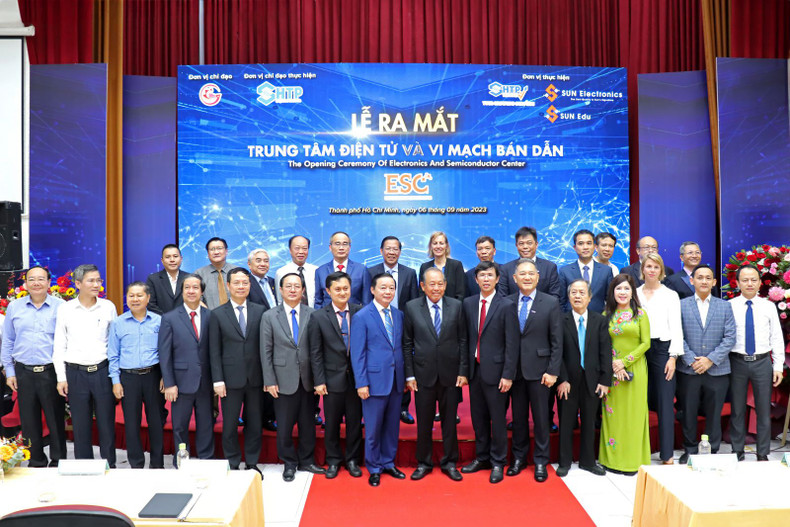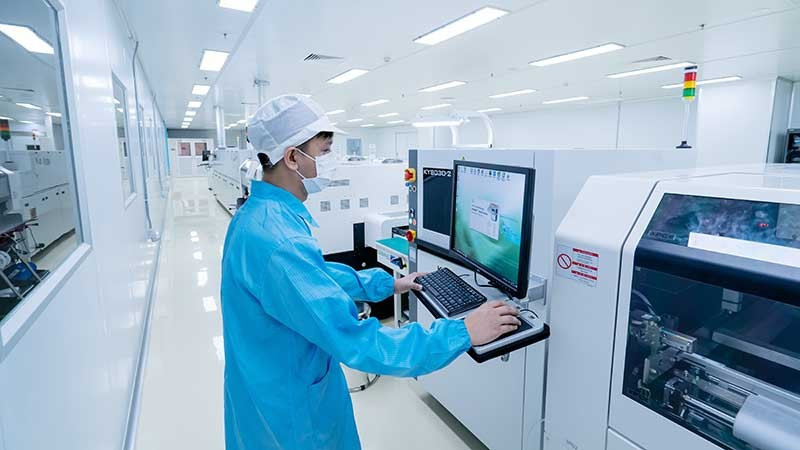The semiconductor chip shortage in recent years has “paralysed” production lines in several countries. In that context, the semiconductor industry in Southeast Asia has emerged as a solution, and Vietnam, in particular, is expected to become the focus of the global semiconductor value chain.
In the context of the strong impact of the fourth industrial revolution, many Vietnamese enterprises have changed their thinking and made bold investments in machinery and human resources to develop the semiconductor industry.
However, human resources in the chip industry in Vietnam are still at the "red alert" level despite receiving great strides in attracting investment and equipment for science and technology transfer.
According to the Ho Chi Minh City Semiconductor Industry Association (HSIA) statistics, 95% of direct investment for microchip technology in Vietnam comes from foreign investors. The whole country has only about 50 semiconductor manufacturing enterprises.
Vietnam currently has more than 5,500 chip design engineers, with 76% of them working in Ho Chi Minh City.
The workforce demand in the semiconductor industry is estimated at 5,000 to 10,000 engineers/year, but only around 20% of its labour demand can be met.
According to Nguyen Anh Tuan, Chairman of the Ho Chi Minh City Semiconductor Industry Association, Vietnam primarily focuses on chip design, accounting for 52% of the semiconductor production process. The other stages, such as production, packaging, and testing, only make up 48%, but they are still in the early stages of development.
This means that out of the 5,500 semiconductor workers in Vietnam, most focus on design, while there is a significant workforce shortage for the other stages.
Tuan revealed that large corporations in the world’s semiconductor industry have said it’s difficult for them to invest in Vietnam without human resources.
Given this situation, the HSIA has held working sessions with the University of Natural Sciences under the Vietnam National University - Ho Chi Minh City to address the issue.
The semiconductor industry is a high-tech industry that brings much added value and is the foundation to support and promote the development of other fields, thus contributing to economic development depth.
Turing semiconductor into a key industry requires synchronous efforts from the State, educational institutions, and enterprises.
The State should issue policies and regulations to encourage firms to invest in semiconductor research and development. Additionally, have guidelines to assist universities in investing in physical infrastructure, human resources, and expert teams for education and research in this field.
Meanwhile, educational institutions should focus on building standard human resource training programmes, and enterprises should coordinate with universities to train graduates so that they can take on jobs immediately.
Professor Dr Dang Luong Mo, advisor to Ho Chi Minh City National University, said it is necessary to design a clear roadmap and a precise vision in the semiconductor industry from design to manufacturing.
“We need to clearly understand that developing the semiconductor industry is transforming scientific and technological achievements into high value-added goods and creating conditions for Vietnam to establish a new position on the global semiconductor map,” he said.
The Ho Chi Minh City Hi-Tech Park (SHTP) has launched an Electronics and Semiconductor Centre (ESC). The ESC combines the SHTP Chip Design Centre (SCDC) and the International Electronic Training Centre (IETC), both of which have operated in SHTP.
 |
| Delegates at the launch ceremony of the Electronics and Semiconductor Centre (ESC) at the Ho Chi Minh City Hi-Tech Park (Photo: shtp-training.edu.vn) |
The merger of SCDC and IETC into ESC would form a training centre that can satisfy the demands of major investors and increase the ability to attract international collaboration programmes in the future.
The centre’s establishment is also expected to boost the development of the country’s electronic and semiconductor industries.
As Vietnam’s chip-semiconductor industry sees bright opportunities to thrive, human resources training is identified as a top priority.
Under the Government-approved programme on developing human resources for the semiconductor industry until 2030 with a vision to 2050, Vietnam aims to train and develop high quality human resources for the semiconductor industry by 2030, and a strong contingent of semiconductor personnel capable of joining the global value chain of the industry by 2050.
Specifically, by 2030, Vietnam expects to have at least 50,000 engineers and workers with bachelor's and higher degrees in all stages of the semiconductor value chain, along with at least 5,000 personnel with intensive expertise in artificial intelligence serving the semiconductor industry.
Alongside, the country will provide intensive training in semiconductor industry for 1,300 lecturers, while establishing, upgrading and modernising four national-level laboratories along with local-level laboratories at 8 public higher education institutions in the northern, central and southern regions to serve the training of human resources.
















